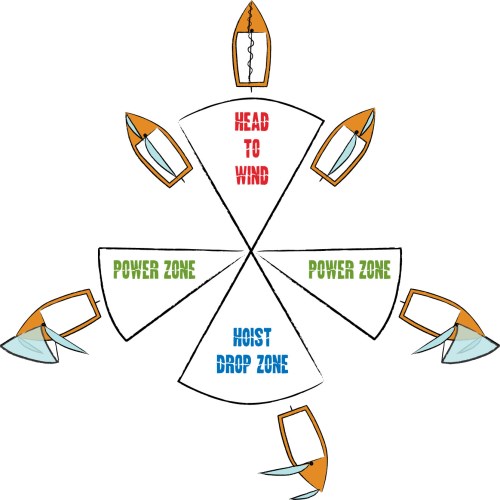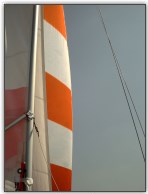Sailing an asymmetric spinnaker
Go To: Sailing - Techniques and Manoevres
Posted on 11 July 2009 17:54
So you have that nice big spinnaker hoisted up the mast, what next? If you try sailing downwind in an asymmetric boat, you’re just wasting lots of money spent on it. So what should you do?
You have to sail across the wind, on a series of reaches down to the next mark. Once the spinnaker is hoisted, you must luff up (head upwind) into the power zone (see diagram 1 below), which is between a beam reach and a broad reach. At this point of sail, the asymmetric spinnaker works best, and gives the most power.

Diagram 1: Hoist/Drop Zone and Power Zone
How do you know how the sail is set? After all, we’re all used to sail settings for a main sail. It’s pretty similar to a symmetric spinnaker for figuring out how well it is set. First of all, the crew really needs to be on the side of the boat opposite to the spinnaker, so they can see it better, as you can’t see it very well through a jib. In lighter winds this might mean the helm having to sit in the middle of the boat, or even on the opposite side, the same side as the main sail. In heavier winds it might mean the crew on the trapeze... but let’s not worry about that for now!
Now you can see the sail, you need to look at the curl of the luff (the side edge that’s nearest the wind). A perfectly trimmed spinnaker will have just a small amount of luff curl, as shown in Photo 2 (the sail will curl back on itself about two thirds of the way up). If the sail curls too much, then you’re overpowering it – if it’s not curled at all, then you don’t have enough tension on the sheet, and the sail isn’t pulled into the wind enough, so the sail won’t be generating as much power as it could. The sail in Photo 1 looks like it is perfectly set to the untrained eye, as it has a nice straight edge - however this is overtrimmed, and needs to be let out a little.

Photo 1, Overtrimmed luff.

Photo 2, Well trimmed luff
Trimming the sail isn’t just a case of getting it to a position where it curls and leaving it – it usually means constant trimming back and forth. As the wind varies by small amounts, the curl will disappear and come back, and the best way to adjust is to very slightly loose the sheet slightly, then pull (trim) it back in to get that curl, every few seconds, to make sure it’s working as well as it could.
The crew will probably be able to see and feel changes in the wind direction and strength in the spinnaker before the helm feels it in the main sheet, and communication is key – if the wind has changed, and you have sailed into a header or a lift, then you may need a slight course variation or even a gybe. Try to keep the boat in the power zone and keep it moving.
Gusts, Headers and Lifts
Handling spinnakers in gusts, headers and lifts is just the same as normal sailing – that is, bear away with the gusts, and head back up when they pass, as the gust moves the wind around.
If you find the wind picking up, the best way to depower a spinnaker is to overtrim it – pull on the sheet hard, and it pulls the sail out of the optimum position for the wind, and it will lose power. This is better than losing it out more, as the spinnaker will simply fill with more wind, and may become wrapped around one side of the boat, or could drop into the water.
Gybing
Gybing an asymmetric spinnaker, you’ll be pleased to hear, is the easiest part! Well, almost. There isn’t any nonsense of changing pole ends around, and the sheet turning to the guy and vice versa – it’s just like a giant jib. The helm chooses when to gybe, communicates to the crew, and goes for it. As the boat moves away from the power zone into the hoist/drop zone the spinnaker depowers, and as the boats gybe and the sails switch sides, the spinnaker does just the same (if it’s been rigged correctly, it should just go around the outside of the forestay).
You can assist the spinnaker through the gybe by keeping tension on the old sheet as the sail starts to gybe, and then release it and it a give a quick tug on the new side to pull it through, but usually it’ll go through with little problem. Easy peasy!
We mentioned bowsprit adjusters in the hoisting article – we’ve known these called as wing wams, but little else. Not many boats have them – the RS400 being one example. In the cockpit, just forward of where the helm sits, are two adjusters, which can be used to angle the pole from side to side. Why would you want to do this? Because you can use the bowsprit angle to angle the spinnaker itself into the wind better, and get more speed. When done, before pulling the bowsprit back into the boat you should centralise this back to the middle.

Photo 3, Wingwams in an RS 400
Asymmetric spinnakers also have an important act on apparent wind, which requires an article all of its own to explain.